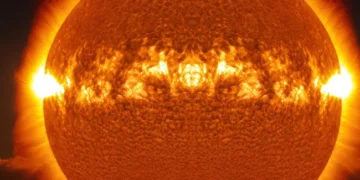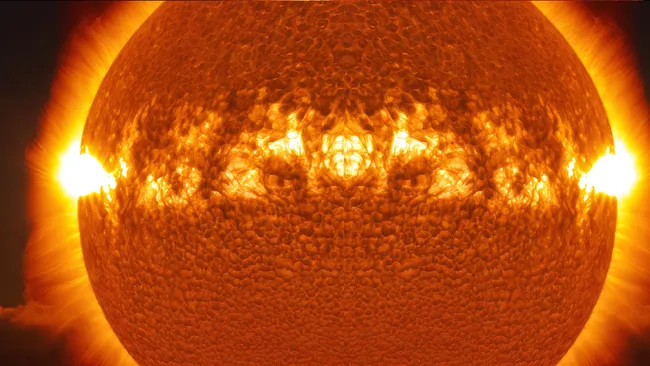The discovery of the ancient star J0524-0336 is reshaping our understanding of stellar evolution, particularly because of its unexpectedly high lithium content. Typically, older stars lose lighter elements like lithium as they age, making this star a compelling anomaly. Researchers used spectroscopy to analyze the star and confirmed its unusual lithium abundance. This has led to new hypotheses about stellar evolution, including unobserved phases of a star’s life cycle or the accretion of lithium-rich material from other celestial bodies.
A Unique Stellar Profile
J0524-0336 stands out among the stars cataloged in the Milky Way. It’s a massive star, around 30 times larger than our Sun, in the late stages of its life cycle. These kinds of stars are usually unstable and display fluctuations in brightness and temperature. However, the defining characteristic of J0524-0336 is its high concentration of lithium—a rarity for such an evolved star.
Astronomers like Ian Roederer initially doubted their findings, thinking they had made an error in the spectroscopy data. Yet, further analysis confirmed that the star’s lithium levels were authentic and far higher than expected. The strength of this lithium signal in J0524-0336’s spectrum has left astronomers intrigued, prompting further study into how this could be possible.
Why Does This Discovery Matter?
The discovery of a star like J0524-0336 challenges established ideas about how stars evolve and produce elements over time. It’s widely understood that during a star’s life cycle, nuclear fusion gradually transforms lighter elements into heavier ones. Lithium, being lighter, tends to get depleted as stars burn through their fuel. For J0524-0336 to maintain a significant amount of lithium suggests there might be aspects of stellar evolution that we have yet to understand.
This is important because lithium plays a crucial role in our models of nucleosynthesis—the processes by which stars create new elements. The presence of lithium in an ancient star hints at new processes that could occur in late stellar life, offering insights into the complex life cycles of stars and their role in shaping the universe’s chemical composition.
Possible Explanations: New Phases or Accretion?
There are two main hypotheses to explain the high lithium content in J0524-0336. The first suggests that this star could be in a previously unobserved phase of stellar evolution. In this phase, it might be undergoing a process that regenerates lithium before it is fully burned off. This would mean a significant revision to our understanding of how aging stars change chemically over time.
The second hypothesis proposes that J0524-0336 may have recently interacted with another celestial body, such as a planet or a smaller star, absorbing material rich in lithium. In this scenario, the star could be in a transitional state, where it has acquired new material but hasn’t yet fully processed it through fusion.
Astronomer Rana Ezzeddine suggests that both of these processes could play a role in the star’s lithium levels. For example, a mass loss event, such as an interaction with another star or planetary body, could leave behind traces of dust in the star’s circumstellar disk. Alternatively, if no such disk is found, the lithium enrichment might point to an internal process yet to be fully understood.
Impact on Current Models of Stellar Evolution
This discovery could lead to adjustments in current models of how stars evolve. Typically, models predict that as stars age, they become depleted of lighter elements like lithium, and their core processes focus on creating heavier elements like carbon and oxygen. Finding a lithium-rich star challenges this narrative and suggests that the process might be more dynamic than we thought.
If J0524-0336’s lithium content is due to a previously unknown evolutionary phase, it could mean that other stars may also have hidden phases where they retain or even regain lighter elements. This would have significant implications for how we study ancient stars and understand the history of our galaxy.
What Comes Next: Further Study of J0524-0336
To uncover more about J0524-0336, astronomers plan to continue observing the star, using advanced spectroscopy techniques to delve deeper into its chemical makeup. Observatories equipped with the latest telescopes and instruments will allow scientists to detect any potential circumstellar disks or interactions with nearby objects.
By mapping out the star’s surroundings and analyzing its spectral data, researchers hope to pinpoint the processes responsible for its lithium abundance. This could either confirm the presence of a circumstellar disk, indicative of a recent accretion event, or reveal other factors that could explain the star’s unusual composition.
Broader Implications for Galactic Evolution
Beyond the details of J0524-0336, this discovery highlights how little we still understand about the evolution of the universe’s stars. As stars age and change, they influence the surrounding environment, contributing to the formation of planets and potentially seeding the cosmos with the elements necessary for life.
Understanding these processes in greater detail helps us construct a more accurate picture of how galaxies like the Milky Way formed and evolved. Discoveries like that of J0524-0336 can offer new clues about the conditions present in the early universe and how different types of stars might have contributed to its evolution.
Moreover, the case of J0524-0336 emphasizes the importance of re-examining established theories in light of new evidence. As advanced telescopes and instruments like those used in this study become more prevalent, we may find other stars that challenge our expectations, each one providing a new piece of the cosmic puzzle.
Conclusion: Embracing the Mysteries of the Cosmos
The discovery of the lithium-rich star J0524-0336 is a reminder of how much we still have to learn about the universe. It shows that even with centuries of astronomical study behind us, the cosmos has surprises waiting to be uncovered. For scientists, the presence of unexpected elements in such an old star is an invitation to revisit and refine their understanding of stellar evolution.
This star could help us unravel new aspects of how the universe’s elements were formed and distributed over billions of years. As we continue to study J0524-0336 and other similar anomalies, we can expect to gain a deeper appreciation of the complex forces that have shaped the universe we see today. And for those of us fascinated by the mysteries of the night sky, it’s a reminder that every new discovery has the potential to change how we see the stars above us.
Reference:
Jeremy Kowkabany et al, Discovery of a Metal-poor Red Giant Star with the Highest Ultralithium Enhancement, The Astrophysical Journal



















